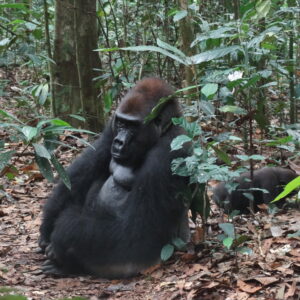Liboue Sector, located within the Dzanga-Sangha Special Reserve, is a moist forest part of the second largest tropical rainforest in the world, the Congo Basin Rainforest which spans across four countries. In 2012 the TNS, which Liboue Sector forms a part of, was designated a UNESCO World Heritage Site.
The bordering National Park is famed for Dzanga Bai, a forest clearing and meeting point of thousands of forest elephants, as seen in the documentary series Africa by David Attenborough.
In the National Park there is also the scientifically important Primate Habituation Programme and the Elephant Listening Project run by Cornell University since 1999 with world renown researchers like Andrea Turkalo and Mike Fay.
Seventeen primates including Western Lowland Gorillas, Central Chimpanzees and three species of Pangolin call this primary forest home, containing trees over 300 years old and 60 meters tall.
Many of these trees have remained intact from logging as they are less accessible, however it is only a matter of time that they too will be felled if the area is not actively protected.
The Ba’aka, local hunter gatherers, have roamed this forest for an estimated 20,000 years. It is crucial to empower these communities to continue to be the guardians of this ancient forest.
We have a strong partnership with Sangha Lodge and the Sangha Pangolin Project (SPP) who have been protecting this former hunting concession for over 10 years now. Local employment opportunities have been created through eco-tourism activities as well as pangolin research and rehabilitation.
Our ambition is to create a model for what is possible in a relatively small area of moist forest working in collaboration with the local community of the Dzanga Sangha Protected Area.
What do we do? We have three primary areas of focus
(i) Wildlife and Forest Conservation: in partnership with Sangha Lodge we help lease primary moist forest and employ the local community as eco-custodians to protect the forest and the many species living here. Sensitisation programmes are run in the wider community to ensure the sustainability of the project.
(ii) Economic Opportunities: We work with the Ba’aka hunter gatherers and wider community to develop economic opportunities whilst maintaining an intact and healthy forest.
(iii) Rainforest Network: Through outreach and research, we aspire to become a resource hub to deepen our understanding of moist forests and rainforests.
Why is Liboue Sector so important?
Liboue Sector serves as a national park buffer zone
The 72,000ha concession forms part of the buffer zone north of the Dzanga-Ndoki National Park, part of the Sangha Tri National forest landscape that spreads across the Republic of Congo, Central African Republic and Cameroon. Buffer zones are critical for adding a level of protection to National Parks, helping maintain the relationship between human populations and the forest flora and fauna.
Our local partners, Sangha Lodge, currently have a 20 year lease (from Nov 2018- Oct 2038) of a 72,000ha concession which the funding will go to protecting. Funding will also go towards purchasing additional leases for up to 250,000ha. This could potentially take the total area protected by Sangha Lodge up to 322,000ha out of the 335,900ha Dzanga Sangha Special Reserve.
To put the significance of this area into context, the Dzanga Sangha National Park is only 126,000ha so we are more than doubling the protected areas.
Threatened Flora & Fauna
This forest is one of the last remaining wildlife refuges for charismatic species such as Forest Elephants, Western Lowland Gorillas and Central Chimpanzees. There are over 100 mammal species including 17 primates, 3 species of pangolins, Lowland Bongo, Sitatunga, Blue Duiker, Forest Buffalo, Giant Forest Hog, Red River Hog, as well as over 400 birds species including the rare Picathartes. Many are seed spreaders and have an easily recognizable impact on the growth and shape of the forest.
Elephants, known as ‘keystone species’ are essential to maintain the biodiversity of the forest. Through their eating habits they even boost carbon stocks. Quoted from this study ‘each forest elephant can stimulate a net increase in carbon capture of these rainforests of 9,500 metric tonnes of CO2 per sq km.’
Without bats, birds and insects the flowers are not as productive, and the fruits do not attract the megafauna. The forest has over 1000 species of documented plants including tress such as African Ebony, Sapele Mahogany, and Iroko.
Climate Change
Moist forests provide a significant carbon sink and on average primary forests store around 35% more carbon. Reducing emissions alone is not sufficient. This must be done in conjunction with carbon sequestration.
The presence of a healthy population of elephants (0,5-1 animals per 100ha) increases the Above Ground Biomass by 26-60 tons per hectare.
Biodiversity
In addition to the dense forest, the area contains a network of baïs, forest clearings, which are crucial for biodiversity. These baïs provide a habitat for antelope, buffalo and smaller plants and amphibians.
The baïs are created by megafauna (forest elephants, buffalo, hogs) as they dig for trace minerals which are important for their and many other species health and digestion. As baïs are a hotspot of animal activity they are critical for research but also vulnerable and exploited by poachers.
Deforestation
The Liboue Sector is accessible by road, making it easily exploited for its natural wealth. Questionable logging practices, illegal diamond mining, poaching of animals for tusks and scales, clearing of forests for agricultural purposes are a threat to the forest ecosystem on which animals and people survive.
Research
The Sangha Pangolin Project (SPP) is conducting research on little known pangolin species. These creatures have almost no general information (gestation, lifespan, populations) recorded yet are thought to be the most trafficked mammal in the world.
Recently interest in pangolins has soared in part due to the coronavirus pandemic. SPP is also contributing to basic data collection and identification of other lesser-known species (squirrels, anomalures, flying mouse, birds, bats etc.), by recording their presence and extending their known distribution.



